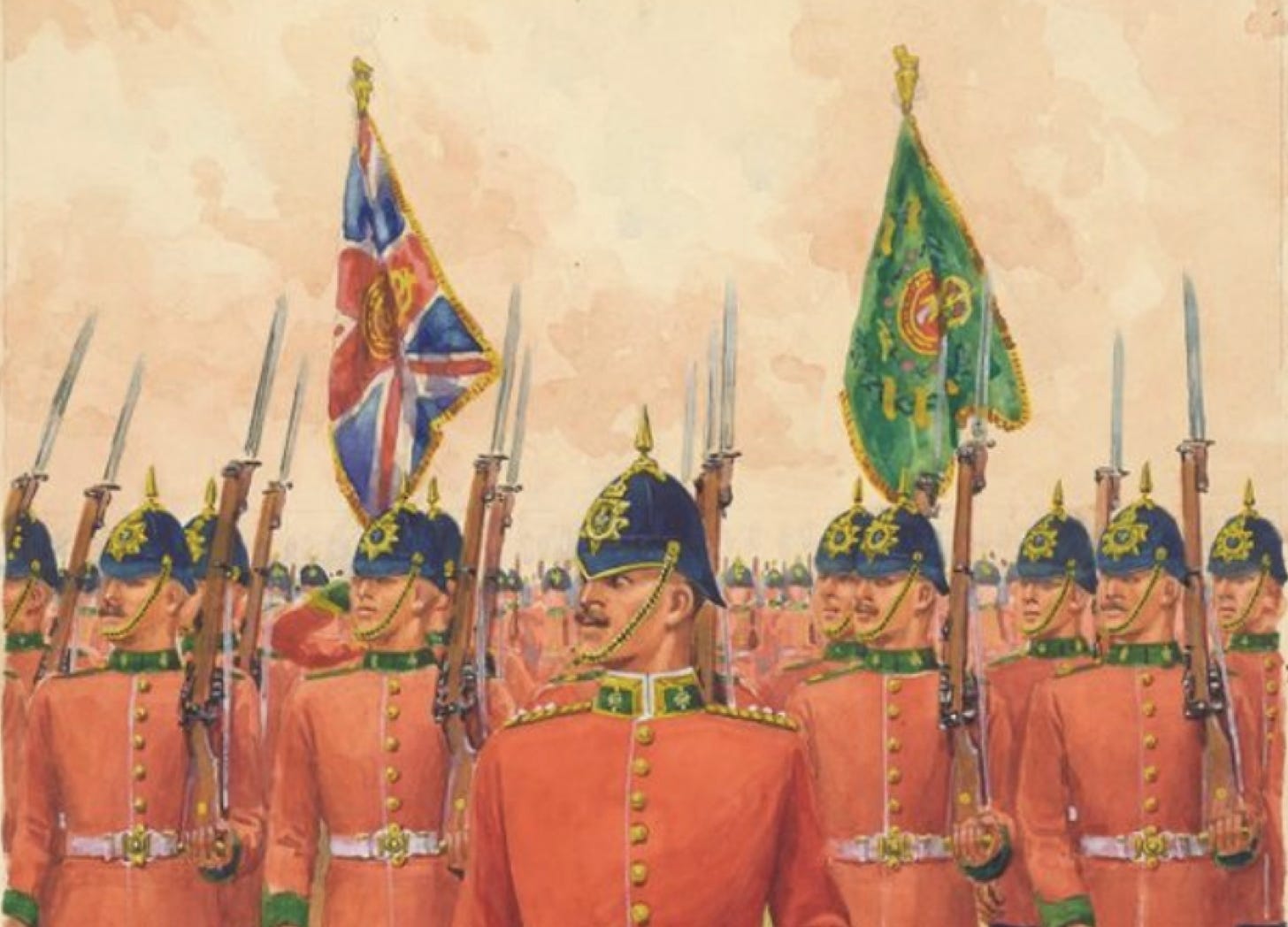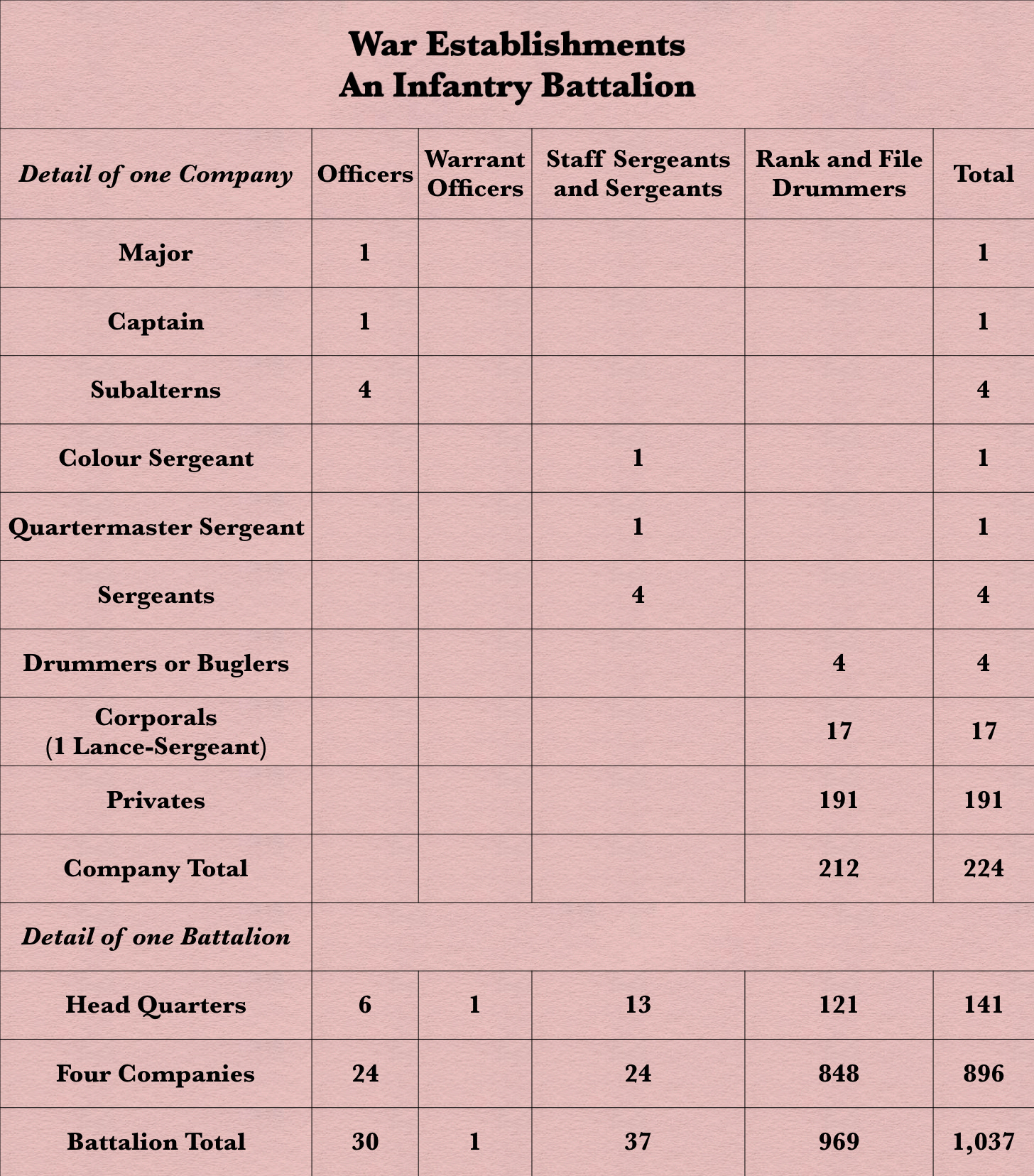Establishments
Battalion Organization (Part VI)
This post continues the serialization of Battalion Organization, an article, published in 1912, in the Journal of the Royal United Service Institution, that argued for the replacement of the traditional eight-company battalion with a unit made up of four much larger companies. A copy of the original article can be found here, at the Military Learning Library.
Links to earlier posts in this series can be found below:
The Four Company Battalion with Headquarter Section
There is nothing new in the idea of a four-company battalion, nor is there any magic in its composition. Nevertheless, the result of clearly thinking out a system and adapt-ing its component parts to the tasks they have actually to confront is almost magical, when we are dealing with human beings.Therefore let us build up our battalion, starting with the squad as our fire unit for war purposes. This squad should, in my opinion, be commanded by a corporal, and should consist of one lance-corporal and ten to twelve rifles (privates). That is the greatest number of men whose collective fire can be controlled by one non-commissioned officer. In this paper I am taking the squad at:
1 corporal.
1 lance-corporal (unpaid).
10 privates.
Total 12
Four such squads would be a convenient number in a section, commanded by a subaltern. He should have a sergeant to assist him and take his place whenever he is absent. He will be held responsible for the training and well-being of his section, under the personal supervision of the company commander. Four such sections will make an admirable company, commanded by a major (mounted) with a captain as second in command, who should be specifically in charge of company administration.
A color-sergeant, a quartermaster-sergeant, one lance-sergeant, and other details will complete the company staff. Total war establishment all ranks 224, as shown in the table given below. There should be four such companies in a battalion, commanded by a lieutenant colonel, with the senior major as second in command who should be specifically in charge of the Headquarter Section (141 of all ranks.) To simplify reference I give the war establishments of a company and a battalion on this page.
It will be noticed that the proportion of officers to men remains unchanged in the companies. This is an essential feature of the new scheme. If a four-company battalion entailed a reduction in the present pro-portion of officers to men, I would oppose any change on that ground alone.
The above battalion total of 1,037 compares with the present authorized total of 1,016, and involves an increase of 21 only.
The Peace Establishment
The difference between peace and war establishments will be that in peace the number of privates, as given above, will be greatly reduced. The other ranks will remain unaltered, so as to retain our chain of command, a priceless asset on mobilization. And here a question may be interpolated to which I have never seen an adequate reply. Our present peace establishments allow for a battalion serving abroad, 29 officers and 46 sergeants, but for a battalion at home only 25 officers and 39 sergeants of all kinds.
Yet just consider the situation of each on the outbreak of hostilities. The battalion abroad departs for the war with seasoned men, nota single recruit, not one reservist, no chain of command snapped, all in apple-pie order. Good! But the battalion at home, short of officers, short of sergeants, with the barrack square crowded with recruits, has nevertheless to incorporate into its ranks, on mobilization, 400 to 600 reservists at one day’s notice, and then go and fight for its life and for England’s life within a couple of weeks.
Can anybody call its either reasonable or excusable to allot such a task to a home battalion, and yet deny it the staff which is indispensable to a foreign service battalion? Quem Deus vult perdere prius dementat. [“Whom God wishes to destroy, he first makes mad.”] So much for the war situation: but how does the matter stand in peace? Why, in peacetime the home battalion wants officers and sergeant more than battalion abroad, for the simple reason that its time is spent in train-ing young soldiers, and fitting them to go abroad. And this is another reason for suggesting that our future organization shall retain its full cadre in peace time, and that the peace reduction shall be in privates only. At this moment, the peace establishment allows 680 privates to a home battalion and I propose to retain it at that. The battalions abroad to have a war establishment of all ranks as detailed above, or as they now possess. Thus my proposals amount to an alteration in the peace establishment of battalions of the Expeditionary Force as follows: Increase, Officers, 5 subalterns. Increase, 32 corporals, of whom 4 will be in the Headquarter Section. Decrease, 2 sergeants.
The next post in this series is:
For Further Reading:
To Subscribe, Support, or Share:















Whom Gods wish to destroy they first teach …. To obey.
Yes.
This is 1912 you know. But with nukes, which are forgotten.